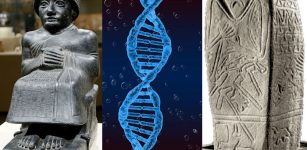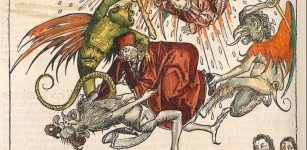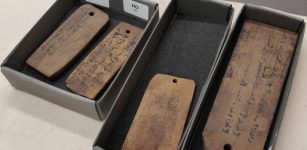Baba Yaga: Enigmatic, Powerful Archetypal Witch In Slavic Folklore
A. Sutherland - AncientPages.com - Baba Yaga (Baba Jaga) is the archetypal witch from Slavic folklore and beliefs.
Baba Yaga - Vasilisa the Beautiful by Ivan Bilibin, 1900. Image credit: Ivan Bilibin - Public Domain
Baba Yaga lives somewhere inside or just outside a forest in a small cottage that stands on chicken legs or chicken feet (or sometimes a single chicken leg) and she flies by sitting in a mortar, which she controls ahead using the pestle.
She is a witch often depicted as being bent over the magic cauldron surrounded by herbs and magical objects; she combines herbs preparing potions and cures.
She uses it to sweep away traces, so no one can catch her. Baba Yaga plays different roles in different kinds of folk tales. She may, for example, help someone in need, give good advice or revenge. Sometimes she is evil.
Baba Yaga. Image credit: Viktor Vasnetsov (1848–1926) - Public Domain
Baba Yaga's origin is not clear. In this enigmatic mythological figure, there are traces of shamanism, animism, totemism, so her status and abilities vary from one story to another.
According to many researchers, she symbolizes old and ugly women with certain supernatural powers.
Baba Yaga is famous figure in Slavic mythology and through the ages, many different and most unbelievable characteristics are attributed to her.
In ancient times, superstitious people had avoided mentioning her name; instead, they assigned her various nicknames. Personalized with different things, Baba Yaga has often been associated with evil things, such like abduction of souls and death. In certain myths, she is an evil female dragon, crow or fox; in others, she is 'almost' human-like, without any characteristics of an animal.
Baba Yaga keeps track of women's housework; she is also the guardian of life and death.
In Slavic folklore and beliefs, Baba Yaga is presented in three different ways.
First, she is a woman-warrior who handles Kladenets-sword (a fabulous magic sword in some Old Russian fairy tales) and fights together with the strongest of warriors.
Second, she is a kidnapper of children by inviting them to her cottage. Later, the children must find a way to outsmart Baba-Yaga and escape.
Third, she is a guide to all heroes who visit her in her cottage. She treats them with food and drink, gives advice and guidance.
For many centuries, the character of Baba Yaga has been demonized by the church, in an attempt to destroy the complex character of this fairy tale figure.
Baba Yaga. Image credit: Ivan Bilibin (1876–1942) - Public Domain
The church has failed. Until today, Baba Yaga – even if she sometimes can be evil - is portrayed as a wise elder woman who provides guidance and advice to people who seek it.
Variations of the name Baba Yaga are found in the languages of the Eastern Slavic peoples. The first part of 'Baba Yaga's name - 'Baba' means 'woman', or, more exactly, 'old woman'. The same word is still used in Serbo-Croatian and Bulgarian cultures to describe both grandmother and old woman in general.
Modern Russian word for 'Baba' is 'babushka' (meaning 'grandmother') and in Polish people say - 'babcia' to describe an older woman, but 'Baba' means 'vicious or ugly woman'.
Mythical figure of Baba Yaga has numerous counterparts in the beliefs of the European people and their close neighbors. She resembles Frau Holle mentioned in ancient Germanic tales and a famous witch Bogorkań (Bogorkan) in Hungarian folklore. In the Czech ancient tales, Baba Yaga is called Baba Drasznica; she is an evil creature - Mother of Dragons - riding the dragon instead of a broom.
One of the most frequent descriptions of Baba Yaga is that she is is dressed in rags, lives in the mountains, or in the forest, far from human habitation. who kidnaps girls to her hut, sucks their blood and finally eats them. In the beliefs of for example, the Kazan Tatars, this mythical figure is like a demon. Sometimes, she has been compared to Circe, the famous divine witch in Greek mythology, and goddess of incredible power.
She had the ability to predict the future and transform people into animals, Circe was also a shape-shifter and performed cleansing rituals.
Written by – A. Sutherland AncientPages.com Staff Writer
Updated on Nov 21, 2023
Copyright © AncientPages.com All rights reserved. This material may not be published, broadcast, rewritten or redistributed in whole or part without the express written permission of AncientPages.com
Expand for referencesReferences:
Instytut Archeologii i Etnologii Polskiej Akademii Nauk
B. Dziel, Baba Jaga jako realizacja archetypu Dzikiej Kobiety na przykładzie baśni polskich
Kushnir, D. Creatures of Slavic Myth
More From Ancient Pages
-
 Immense Ancient Copper Mine Used By Romans Unearthed In Spain
Archaeology | Mar 20, 2017
Immense Ancient Copper Mine Used By Romans Unearthed In Spain
Archaeology | Mar 20, 2017 -
 Neanderthals Vanishing When Homo Sapiens Emerged In Europe Was Coincidental – Are Herbivores The Answer?
Evolution | Sep 29, 2023
Neanderthals Vanishing When Homo Sapiens Emerged In Europe Was Coincidental – Are Herbivores The Answer?
Evolution | Sep 29, 2023 -
 10 Spooky Ancient Places That Are Home To The Feared Living Dead
Featured Stories | Oct 31, 2020
10 Spooky Ancient Places That Are Home To The Feared Living Dead
Featured Stories | Oct 31, 2020 -
 Glorious And Scary Orava Castle – Realms Of Nosferatu And A Historical Landmark Of Slovakia
Featured Stories | Jan 24, 2020
Glorious And Scary Orava Castle – Realms Of Nosferatu And A Historical Landmark Of Slovakia
Featured Stories | Jan 24, 2020 -
 First Pompeiian Human Genome Sequenced Fron An Individual Who Died After The Eruption Of Mount Vesuvius In 79 C.E
Archaeology | May 26, 2022
First Pompeiian Human Genome Sequenced Fron An Individual Who Died After The Eruption Of Mount Vesuvius In 79 C.E
Archaeology | May 26, 2022 -
 Beautiful Ancient Viking Jewelry Made By Skilled Craftsmen
Artifacts | Dec 29, 2015
Beautiful Ancient Viking Jewelry Made By Skilled Craftsmen
Artifacts | Dec 29, 2015 -
 8000-Year-Old Prehistoric Çatalhöyük: Residents Were Buried In Their Homes
Archaeology | May 1, 2020
8000-Year-Old Prehistoric Çatalhöyük: Residents Were Buried In Their Homes
Archaeology | May 1, 2020 -
 Controversial Roman Emperor Heliogabalus Wanted To Be A Woman And Much More
Featured Stories | Jun 14, 2020
Controversial Roman Emperor Heliogabalus Wanted To Be A Woman And Much More
Featured Stories | Jun 14, 2020 -
 Cursed Biblical City Bethsaida May Have Been Found – But Scientists Argue About The Discovery
Archaeology | Sep 1, 2020
Cursed Biblical City Bethsaida May Have Been Found – But Scientists Argue About The Discovery
Archaeology | Sep 1, 2020 -
 Ancient DNA Reveals Missing Link In The History Of Indo-European Languages
Linguistic Discoveries | Feb 5, 2025
Ancient DNA Reveals Missing Link In The History Of Indo-European Languages
Linguistic Discoveries | Feb 5, 2025 -
 Ancient DNA Provides Comprehensive Genomic History Of The “Cradle Of Civilization”
Archaeology | Oct 10, 2022
Ancient DNA Provides Comprehensive Genomic History Of The “Cradle Of Civilization”
Archaeology | Oct 10, 2022 -
 Anomalies Linked To L-Shaped Structure Detected At The Western Cemetery, Giza, Egypt
Archaeology | May 11, 2024
Anomalies Linked To L-Shaped Structure Detected At The Western Cemetery, Giza, Egypt
Archaeology | May 11, 2024 -
 Simon Magus ‘The Magician’ Who Faked Death And Resurrection
Featured Stories | Feb 17, 2022
Simon Magus ‘The Magician’ Who Faked Death And Resurrection
Featured Stories | Feb 17, 2022 -
 Four Magical Treasures Of Tuatha De Danann
Celtic Mythology | Jan 23, 2023
Four Magical Treasures Of Tuatha De Danann
Celtic Mythology | Jan 23, 2023 -
 Mystery Of The Medieval ‘Out Of Time’ Village In England
Featured Stories | Mar 21, 2024
Mystery Of The Medieval ‘Out Of Time’ Village In England
Featured Stories | Mar 21, 2024 -
 Runic Inscription On The Viking-Age Galloway Hoard Deciphered
Archaeology | Feb 13, 2025
Runic Inscription On The Viking-Age Galloway Hoard Deciphered
Archaeology | Feb 13, 2025 -
 Scientists Reconstruct The Climate Of The Ancient World Using Small Wooden Artifacts And Mummies
Archaeology | Apr 5, 2023
Scientists Reconstruct The Climate Of The Ancient World Using Small Wooden Artifacts And Mummies
Archaeology | Apr 5, 2023 -
 Ancient People In Chaco Canyon Who Had Six Fingers And Six Toes Were Special – Researchers Say
Archaeology | Mar 16, 2022
Ancient People In Chaco Canyon Who Had Six Fingers And Six Toes Were Special – Researchers Say
Archaeology | Mar 16, 2022 -
 Roman-Era Girl Buried And Adorned With 1,700-Year Old Gold Jewelry Found In Pagan Cave
Archaeology | Apr 8, 2023
Roman-Era Girl Buried And Adorned With 1,700-Year Old Gold Jewelry Found In Pagan Cave
Archaeology | Apr 8, 2023 -
 Unusual Secret May Be Hidden In A Mysterious Valley In The American Southwest
Featured Stories | Jan 30, 2024
Unusual Secret May Be Hidden In A Mysterious Valley In The American Southwest
Featured Stories | Jan 30, 2024



